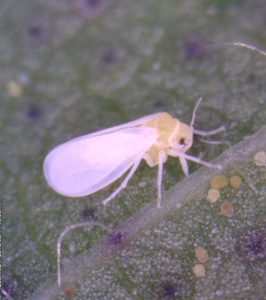
Silverleaf whitefly adult (actual size is less than one millimetre long)
As part of the cotton industry’s proactive approach to managing resistance risks, there is an ongoing program of resistance surveillance in the major pest species.
Resistance to spirotetramat (Movento®) was first detected in silverleaf whitefly (SLW) in the Burdekin region in 2016.
From 2016–2024, 131 SLW populations have been collected and tested for resistance to spirotetramat, 4 populations were from the Burdekin region and were all resistant, the remainder were collected from cotton growing regions, and recently this has included the Lockyer Valley.
Testing during 2024 has indicated that resistance selection is occurring in SLW, with a significant increase in the prevalence of resistance to this Group 23 insecticide across a wide geographic range (Table 1). Fortunately, the current level of resistance at most localities is still low. However, in the past two years testing has detected high to very high resistance in the Lockyer Valley, meaning Movento® is unlikely to provide adequate control of SLW in either the Lockyer or Burdekin/Bowen regions in the foreseeable future.
Resistance in silverleaf whitefly to Movento® is due to the presence of a target site mutation (A2083V). It has the potential to rapidly increase due to SLW genetics (dominant inheritance of A2083V and haplodiploid sex determination) and once entrenched, is unlikely to revert to low levels. Therefore, resistance management is highly reliant on minimising selection pressure.
For the cotton industry this means adhering to the current Insecticide Resistance Management Plan (included in the latest Cotton Pest Management Guide and available at the CottonInfo website https://cottoninfo.com.au/publications/stewardship-insecticide-resistance-management-strategy), which limits Movento® to a single application per season for whitefly control. Rotating between mode of action groups is another critical approach to reducing selection pressure and it’s essential that appropriate pest monitoring is implemented and spray thresholds are considered in all management decisions.
Biological control is an important component of integrated pest management (IPM) and numerous natural enemies of whiteflies that can help suppress pest population buildup, including predator bugs and beetles, lacewing larvae, spiders, and parasitoid wasps (Eretmocerus & Encarsia) inhabit cropping systems. Parasitoid wasps can also be purchased and released into fields to provide augmentative control.
Other important IPM practices include removal of alternative hosts and destruction of harvested horticultural crops that can provide a breeding ground for whitefly. In horticultural regions adoption of area-wide summer production breaks of whitefly susceptible crops can reduce whitefly numbers and reduce resistance selection pressure.
Pulse producers have access to spirotetramat for SLW control under permit PER89779 (expires 31 March 2026). While the permit specifies a maximum of two applications per crop, a single application per season is preferable to minimise resistance risk.
Further information
Information on sampling and thresholds for SLW in cotton can be found at the CottonInfo website.
Examples of service providers of parasitic wasps for SLW management and field application services include:

